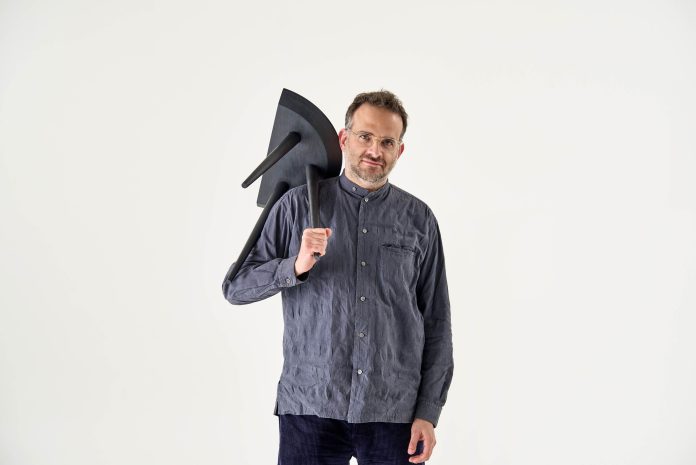Acclaimed architect Amos Goldreich has revived his parents’ furniture designs and celebrates them with new brand TAMART.
Here, Amos shares how he dipped into the family archives and brought the designs of the past to life with a contemporary twist.

Tell us about your design background and the inspiration behind the brand.
My journey as an architect began at the Architectural Association, followed by experiences with prestigious firms like David Chipperfield, Stanton Williams, Haworth Tompkins, and Feilden Clegg Bradley Studios. In 2010, I founded Amos Goldreich Architecture, specialising in residential, commercial, and social projects, deepening my appreciation for architecture’s role in shaping communities.

The inspiration for TAMART comes from my parents, Tamar de Shalit and Arthur Goldreich, esteemed modernist architects. Their extensive archive, discovered posthumously, formed the foundation for TAMART this year. With over 10,000 original plans, photographs, documents, and prototypes, their legacy influenced TAMART profoundly. Their partnership and passion for design, cultivated at London’s Central School of Arts and Crafts, shaped TAMART’s ethos.

Inheriting my parents’ archive compelled me to revive their designs, leading to the creation of TAMART. Our inaugural collection features ten pieces, including tables, chairs, and stools, crafted to honour their original designs while embracing contemporary aesthetics. TAMART’s mission is to celebrate their legacy through timeless designs that bridge past and present.

What does TAMART represent as a design brand?
TAMART represents a convergence of heritage and innovation in the design industry. It encapsulates the spirit of my parents’ modernist principles while infusing contemporary relevance into their iconic designs. Each piece within the collection embodies the distinctive style and philosophy of Tamar de Shalit and Arthur Goldreich, emphasising the synergy between form and function. The brand aims to cater to modern tastes while celebrating the innovation and craftsmanship of the past.

What has been the reaction to the brand so far?
Our launch during Milan Design Week was highly successful, and the response to TAMART has been overwhelmingly positive thus far. I had conversations with several individuals in Milan who were genuinely moved by the story behind the brand. Our dedication to quality craftsmanship, sustainability, and its distinctive narrative, rooted in the legacy of my parents, has certainly struck a chord with audiences.

What is the biggest challenge for TAMART in the global furniture design industry?
The biggest challenge for launching a new furniture brand relying on independent craftspeople lies in ensuring consistent quality and timely production. We coordinate with multiple artisans, each with their own schedules and capacities, thus balancing the need for flexibility with the imperative of reliability.

How do you tackle issues surrounding sustainability in the design industry in your own studio and processes?
We manufacture all TAMART pieces in the UK and Europe, prioritising sustainability and quality craftsmanship. Using FSC-certified timbers like oak, ash, and black-stained ash sourced from responsibly managed forests, along with locally sourced materials, minimises environmental impact and supports regional economies. Our upholstered pieces feature natural wool textiles from Mourne Textiles and Bute Fabrics, avoiding the use of foam. Additionally, we collaborated with Bute Fabrics to create Contrast, a bespoke black and white woven fabric based on an original design by Tamar de Shalit. The Highgate Chairs and Red Rock Club Chair offer natural vegetable-tanned leathers in chestnut, black, and natural colours. Our commitment to sustainability extends to employing sustainable production techniques, ensuring repairability and recyclability of all TAMART products.

What are you focused on for the remainder of the year?
Our current focus is on solidifying TAMART’s physical presence in the UK as well as in key markets globally. Additionally, we’re strategising for a London event later in the year to sustain the momentum generated from our successful debut in Milan and to further cultivate relationships within the design community.

What does TAMART aspire to look like in 10 years time?
I am excited about the potential for future development of the brand, which, of course, holds personal resonance for me. Therefore, it is something I am deeply attached to. In 10 years, TAMART aspires to be recognised as a leading contemporary furniture brand with a global presence, synonymous with quality craftsmanship, timeless design, and sustainable practices. I envision a diverse portfolio of products that resonate with a wide range of consumers while maintaining the integrity of my parents heritage and story.
TAMART aims to continue honouring the legacy of Tamar de Shalit and Arthur Goldreich, inspiring future generations through their enduring commitment to creativity, innovation, and excellence in design. With an extensive archive of drawings, prototypes, and photographs at our disposal, we’re poised to expand our product range and continue to create new designs inspired by the archive.






